► The best luxury hybrid cars rated
► Plug-in hybrids and self-charging hybrids included
► Here’s our fully updated expert list
This list of the best luxury hybrid cars on sale in the UK is a clear demonstration that the best hybrid cars are in no way limited to small, eco-centric shopping chariots any more. These days, many buyers won’t touch anything at any level unless the vehicle has some hybrid capability to offset the environmental impact of their indulgence.
The systems available in the luxury sector run the full gamut of hybrid technology – from barely there mild-hybrid starter-generators to the kind of self-charging hybrids made famous by Toyota, right through to long-range plug-in hybrids with chunky batteries and lengthy electric-only driving ranges. We’ve taken out mild-hybrids from this list, given they are now commonplace in most luxury vehicles.
The best luxury hybrid cars at a glance:
We’ve rounded up hybrid luxury cars in a range of body styles for CAR’s list of the best. But if you already know you want a hybrid SUV you can check out our specific guide on those; similarly we also have round-ups dealing with the best hybrid estates and more affordable hybrid cars as well.
The best luxury hybrid cars 2025
Mercedes-Benz S580e L
Best for those who want the best luxury hybrid overall
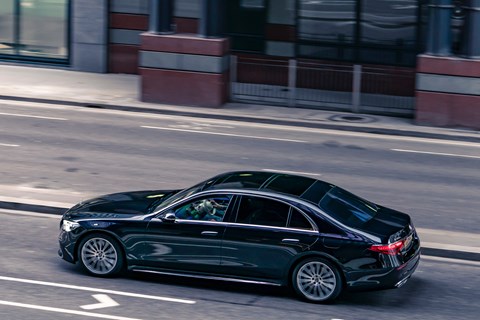
Pros: Sonderklasse quality throughout, epic refinement, premium interior
Cons: The BMW 7-Series might be a bit better…
You’ve been able to buy a plug-in Sonderklasse for a few years now, but the current generation has taken a sizeable step forward. Combining a powerful yet smooth six-cylinder engine with a powerful electric motor boosts performance, and it has a truly massive battery to help everything along.
With a claimed 65 mile electric-only range it’ll go further than almost any other PHEV, and it’s quick to charge, too. While most plug-ins take hours to top up, DC charging means it takes just 20 minutes to get from 10-80%.
To find out more, read our full Mercedes S-class review
BMW X5 xDrive50e
Best for those who want a hybrid with luxury and strong dynamics
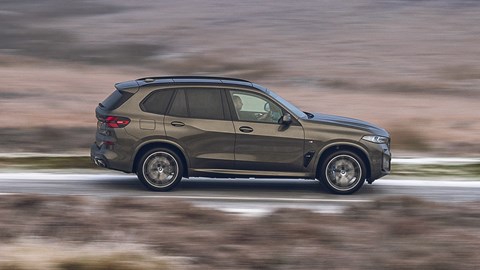
Pros: Winning combination of performance, good economy, strong dynamics
Cons: Not the most attractive car, interior has less physical controls than before
The BMW X5 has been one of the best hybrid SUVs for some time and it’s only got better as part of the most recent update, which comes with a new name – the X5 xDrive50e. Although the cake tastes slightly different this time around, the ingredients are much the same, with a turbocharged straight-six petrol engine doing the duties when you’re not running on volts, but with more power and a longer electric range – BMW claims up to 66 miles.
However, the X5 is plusher inside, better to drive and still usefully practical. Those that want seven seats will need to look elsewhere, though, predominantly at the Volvo XC90 T8 listed further down this list.
To find out more, read our full BMW X5 review
Bentley Flying Spur V8 Hybrid
Best for those looking for the ultimate in handcrafted luxury and performance in equal measure
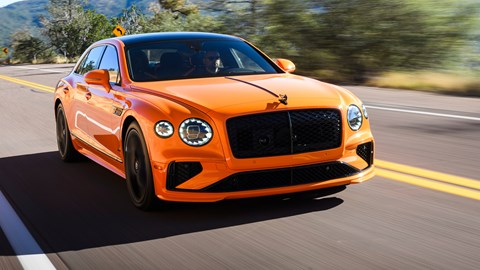
Pros: 771bhp and a clever chassis means performance aplenty, amazing inside, sharp looks
Cons: Tiny boot for such a big car, exceedingly vital options list
Bentley has backed down on its 100 per cent EV plans for now and has started getting serious about plug-in hybrids instead. This new-for-November-2024 Flying Spur Speed abandons the lame electrically assisted V6 of the previous version and glories in a new Ultra Performance Hybrid system instead. This uses a twin-turbo V8 codeveloped with Porsche and a more powerful electric motor to deliver 771bhp.
At the same time, the firm has upgraded the chassis and enlarged the battery pack. So you now get greater comfort, greater dynamics and up to 47 miles of electric-only driving range. This from a near 2.7-tonne car that can do 0-62mph in 3.5sec or achieve over 40mpg on a cruise. It’s still fabulous inside, too, and though the tiny boot could be inconvenient it’s otherwise a performance-luxury dream.
To find out more, read our full Bentley Flying Spur review
BMW 7 Series
Best for those who want a luxury limo but enjoy driving
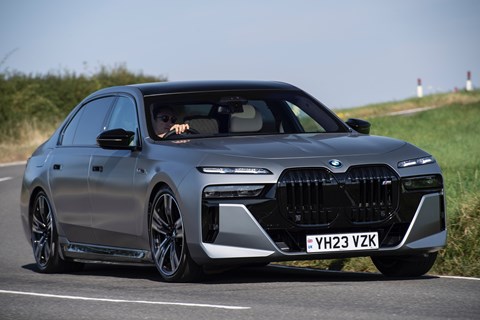
Best for: A luxury limo for those who enjoy driving
Pros: Great to drive, outstanding interior, technology is a step above rivals
Cons: How it looks, not as comfortable as an S-Class
The latest generation BMW 7 Series is known mainly for two things. The first is how it looks (gopping – to our eyes at least) and second is the electric BMW i7, one of the best EV saloons you can buy. While BMW no longer sells regular petrol and diesel versions of the new 7 Series, it is also available as a plug-in hybrid.
There are two tunes of six-cylinder PHEV available – the 482bhp 750e and 563bhp M760e, though the less powerful of the two is our pick of the line-up, and boasts a claimed 55-mile EV range. The latest 7 Series’ interior is outstanding, being packed full of the latest tech (including a panoramic rear TV screen for those in the back) and yet still made to the highest quality.
To find out more, read our full BMW 7 Series review
Lexus RX
Best for those who want an upmarket hybrid SUV that isn’t German
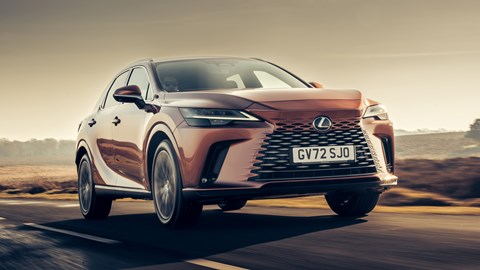
Pros: Fantastic interior quality refinement, better-equipped than rivals
Cons: Not very engaging to drive, rivals have longer EV range
Last year our luxury Lexus hybrid of choice would have been the stunning LC Coupe, but with the model recently being discontinued, we’ll now point you in the direction of something very different from this Japanese firm – the RX, its flagship SUV. If you’re wanting something different to the usual German players, there’s a lot to be said for the RX, which mixes fantastic interior quality with top-tier refinement.
Lexus is known for its hybrid systems, and the RX is the only car on this list available as both a self-charging and plug-in hybrid. The latter is called the RX450+, and brings an electric range of around 40 miles, some way off the competition. But with such an impressive reliability reputation, a long warranty (up to 10 years if you have your RX serviced at Lexus each year) and the firm’s acclaimed dealer network, you’re unlikely to be treated so well with any opposition carmaker.
To find out more, read our full Lexus RX review
Volvo XC90 T8
Best for those with big families who need lots of space
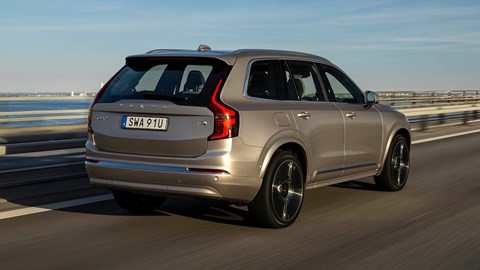
Pros: Great family car, strong safety, masses of space
Cons: Getting expensive, great electric alternative
There aren’t many seven-seater PHEVs, and even fewer that do the job in style and luxury, so the Volvo XC90 is a rare breed indeed. This Swedish family SUV has been around for a while now, and before this year it was beginning to feel its age. Mercifully, though – for the large families of Middle England, at least – the XC90 has been updated for 2024.
It’s now got a subtly revised front end, plus an updated interior with a new, larger, floating infotainment display. Add the tweaks up and the XC90 feels modern and relevant again, though without pushing the envelope to a place where some of its dedicated clientele might feel alienated. Oh, and the T8 engine option is a riot. A 40-odd mile electric only range isn’t much to write home about, but despite the car’s enormous size, with 448bhp, it can really shift its weight around when you want it to.
To find out more, read our full Volvo XC90 Hybrid Recharge T8 review
Porsche Panamera hybrid
Best for those who want a Porsche but need more than the 911’s practicality
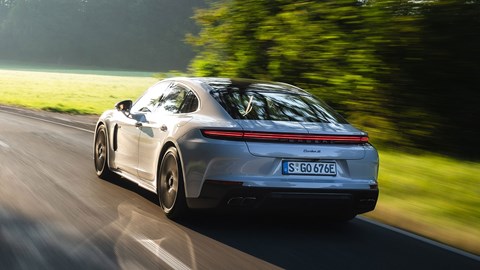
Pros: Staggering performance, luxury cabin, surprising space
Cons: No more Sport Turismo, hilariously expensive options list
Think of this as a cheaper, racier Flying Spur Hybrid and you won’t be a million miles off. Both share a similar hybrid system and platform, with the Panamera forgoing a bit of luxury and comfort for performance and handling. That said, unlike the Bentley, hybrid versions of the Panamera are available with a clever suspension called Active Ride, which essentially works to keep the car completely flat, even during hard cornering.
Various hybrid versions of the Panamera are available, ranging all the way up to ridiculous 771bhp Turbo S E-Hybrid that can leave you feeling quite uncomfortable after a launch. A cheaper hybrid Panamera makes more sense, however, as you still retain all of this luxury limo’s agility and usability. It’s the closest thing you’ll get to a genuine luxury car from Porsche.
To find out more, read our full Porsche Panamera hybrid review
Lexus LM
Best for someone who wants something VERY different – and LOTS of space
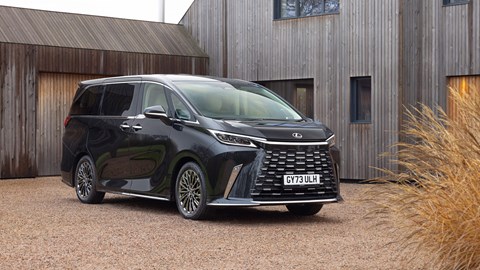
Pros: Huge amount of space, feels genuinely luxurious, superb quality
Cons: Very expensive, could you really live with seeing that grille on your drive?
If you think a luxury car can only come in the form of a grand saloon or big SUV, think again. The Lexus LM is an alternative take on this formula, with a big van-like MPV kitted out with the plushest leather and fanciest rear seats doing an excellent job of feeling like a luxury car. This sort of vehicle are already proving popular in various Asian markets, but the LM is the first to be sold in the UK.
Using a quite unremarkable self-charging hybrid system, the LM is not a driver’s car, but one that exists to cater first and foremost for those in the rear – and surely that’s the point of a luxury car? It comes with seven seats as standard but the top-spec four-seat Takumi model is the one to go for where maximum luxury is concerned. The downside is that the top-spec model costs more than £110,000…
To find out more, read our full Lexus LM review
Range Rover PHEV
Best for those who are style-conscious
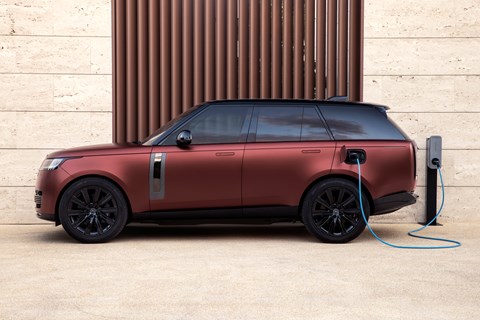
Pros: New look is even better, figures impress too, iconic exterior
Cons: Some may prefer the mild-hybrid diesel
Whether you pick the full-sized Rangey or the smaller Range Rover Sport, the mild and plug-in hybrid engines are very impressive. Arguably the one to go for is the mild-hybrid D350 diesel, a powerplant that’s delightfully smooth, capable of in excess of 35mpg and much cheaper than the P460e PHEV.
Not that the PHEV isn’t deeply impressive. With a class leading electric only range and standard DC rapid charging capabilities, you can rarely bother the straight-six petrol engine under the bonnet. Regardless of engine, it’ll go places where few others can. If you need more ability from your hybrid, you’ll be looking at the Land Rover Defender.
To find out more, read our full Range Rover review
Audi Q7 PHEV
Best for those wanting a big and practical family SUV
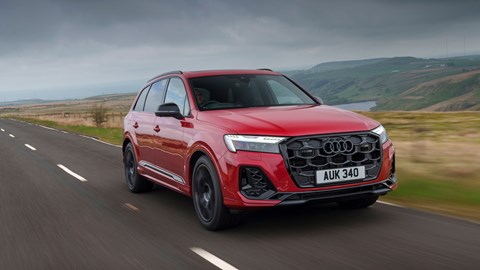
Pros: Very spacious, impressive quality, comfy
Cons: Can’t get the PHEV with seven seats, interior starting to feel a bit old
If you want a big and practical large SUV that manages to be luxurious at the same time, you’ll struggle to beat the Audi Q7. Still the firm’s largest car all these years later, its ability to blend long-distance comfort and refinement is one that most rivals struggle to match. The Q7 is starting to show its age, and despite a recent update, its interior – despite its top-tier quality – does now feel a bit old compared to rivals from BMW and Mercedes.
The Q7’s claimed electric range is also a step behind, with Audi claiming around 50 miles from a charge, though that should still be enough for short journeys and school runs to be completed on EV power.
To find out more, read our full Audi Q7 review
Which type of luxury car hybrid system should I choose?
When looking at a luxury hybrid car, it’s best to work out what you want from it. If you’re a company car user, a plug-in (PHEV) can massively reduce your BIK bills, in some cases to well below far cheaper conventional cars. The best luxury hybrid cars, such as the Mercedes S580e are now also able to run for long distances on electric, potentially offering cheaper fuel bills, too.
If you’re unable to plug in or are buying privately, a full hybrid may be a better bet. A full hybrid such as that available in the Lexus NX and RX SUVs is usually a cheaper option than a PHEV. Even so, it’s still able to give a hearty economy uplift thanks to its ability to store otherwise wasted energy to use later. This is why they’re also known as self-charging hybrids. Fuel economy is generally quite good around town with these, but if you do lots of journeys, efficiency will likely not be too different from an equivalent modern diesel.
We’ve also produced a guide on the pros and cons of hybrid cars, if you’re still not sure which powertrain to choose in 2025.